Genre: Shmup Developer: Sega of Japan Publisher: Sega of America Players: 1-2 Released: 1989
This shooter is mostly a side-scroller courtesy of Capcom. The game can be played with either one or two players simultaneously, providing that you have a friend over for the journey. As the player progresses through the game, a variety of enemies that are mechanical, human, and sort of reptilian or dragon-like in nature will decide to try and stop your progress. By killing them off, they will occasionally drop money (or “Zenny” as the universe of FW has bestowed the name upon its currency as such) which you can use to buy weapons later. Sometimes the enemies and bullets are fast, but most of the time they’re kind of slow, so players should be able to see a fair amount of the game the first time through and certainly the second time.
When the player reaches the end of the level, it becomes time to fight the end boss for the current “region” or area the “Nameless Ones” are currently attempting to liberate from these “Bad Guys.” Bosses provide one, maybe two different styles of attack, but not much else. So, it’s probably safe to say the it will be the stage that kills a player, not an end boss in most situations. This can be quite deceitful to a gamer’s eye, considering the awesome size or graphics that some of the bosses are made of. But not to worry, they do have their tender spots and limitations.
After defeating the level’s end boss, a reward of Zenny will be given based upon how quickly the boss was killed…and the reward is heavy, so players will want to try to beat the boss quickly in order to upgrade to the higher-costing and more damage significant weapons. Then folks get to see a brief cut-scene of the heroes in full-screen glory saying such Rambo tough-guy quotes as “You cannot stop me with just a paramecium!” or “He can’t withstand my aura weapon.” Hehe, gotta love ’em. The only bad part about this reward system is that there is no timer, or any indication given on how quickly you must defeat the boss. I believe that the task probably has to be completed within a minute as it seemed to be the case while playing throughout the game.
One great feature about the game is one that I enjoy immensely in shooters. During the progression of each level, an occasional “shop” will appear from the ground or a structure to which you can fly into. It is at this point that players may use their accumulated funds to purchase weaponry and other optional upgrades. The weapon selections change after each level is finished, with various helpful items like armor (take several bullet hits without losing life), health packs (restore life), resurrection potions (extra 1up), and information (boss strengths & weaknesses). After purchasing whatever you can and mounting up, it’s time to set back out to finish up the level and destroy the boss. Weapons that are purchased are primarily for the satellite. which dishes out all major amounts of firepower, and the weapons that are for sale suit the machine well. Heavy duty lasers, flame throwers and flame bombs, recherché bullets, wide beams, 8 way shots, homing missiles & lasers, dresses (yes, that’s right, a dress. It’ll “do something for you”), etc. are just some of what is available to shop for during your little shopping spree. One thing is sure, the weapon selection greatly enhances the game and weapon rotation is tactically necessary to progress in the later stages. Of course, the main human guy does shoot a standard shot weapon, but luckily, boosters can be purchased specifically for it that will upgrade its power.
Out of all the big plus attributes and standard settings of the game, there are few minor drawbacks. The first is speed adjustment. Now there is a way to set it, either before the game, or when you visit shops and purchase a flying stone, affecting the speed of the satellite’s rotation. The setting of this stone affects both turning degree or rotation and how quickly it can be rotated around the player (the satellite can be moved a full 360 degrees). In addition, the flying stone setting will also determine how quickly you want to reposition the satellite (players can stop firing and then swing the satellite around the hero by turning with A or C, then resuming firing by holding B). Anyway, here’s the catch – Speed adjustment only affects how the satellite works… not how fast the player moves around the screen. I will admit though, I did not find the lack of this feature too troubling, but I’m also not sure how it could have been integrated into the game even if the wanted to do it. In either case, after playing the game completely, I’m surprised that this basic option of shooters was not there given the gross amount of everything else.
I think the graphics speak for themselves. Capcom made sure that the bosses were not only different, but are sometimes huge, taking up the entire screen. Many of the stages also reflect the style of the boss and fit right in together. Reptilian looking guys followed by a dragon boss, Egyptian guys followed by Egyptian god-like bosses, etc. Certainly, good and totally enjoyable. Another big plus was that there were plenty of large objects to shoot at. Huge mechanical gears that come tumbling down, worm dragons swooping in from the clouds, blockade doors slamming down in front of your path, and giant water worms shooting out of the ocean to snag you are just some of the obstacles that show up during play, and they are all pretty cool.
While much of the overall graphics of enemies, weapons, & bosses cannot be denied their awesome impact (although debatable since they don’t seem to always fit together in the game with each other, but whatever, the game’s story is a bit odd), there are a few instances were some parts were a little weak. Some backgrounds are either plain black or just hypnotically repetitive to an extreme. These repetitious patterns, given their color on some stages, made it difficult to decipher some of the smaller enemies as they have strange attack patterns that are slow and a little random. So, if the enemies blend in a little too much with the background… well… you see the problem… or maybe you don’t until you get hit. This is a very minor bitch, as the rest of the game is fine and players are able to enjoy defeating these Egyptian-looking bird-god freaks.
The game does not recycle most of the theme music for the stages. All are fair to hear and have their own unique sound to them. Hell, even the bosses have their own themes. So, this is a thumbs up. Now I can say that while this was cool, the tracks themselves were nothing extremely memorable. The music doesn’t suck, but it’s not annoying either. One or two themes stick out a little in my head (like the obvious Egyptian sounding theme on the appropriate stages), but that’s about it. Basically, if I heard the first stage’s music a year from now or less, I probably wouldn’t remember which game it was from or even be able to remotely identify it other than saying it’s probably a Genesis game. I suppose a select few who enjoy the game immensely will derive more enjoyment from basking in the old tunes, but I didn’t find the music to be anything motivational or worth sitting and listening to for an extended period.
Where the game lacks a in its few musical composition, it makes up for in the sound effects department. Capcom made and provided a fair number of sounds to spice up the game. One thing is sure, if I heard some of the sound effects playing WITH the music, I’d be able to identify the game immediately. So, the game does have different shot fire sounds for the weapons and bosses, as well as the various enemies that are encountered along the way. I can also say that the sound effects are unique to the game and have cool sounds. Bonus point for Capcom. Since they were able to do this, it has helped push the game up and out, making it a little more noticeable and recognizable to gamers.
The original arcade game was played with a joystick and a special, small, 360-degree rotating knob. If I remember correctly, the characters automatically are on auto fire, allowing the player’s hands to focus on two things – moving the character around the screen with the joystick with the left hand, and turning the character the direction needed to fire at an enemy with the right hand. Obviously, the Genesis controller doesn’t have this little knob, so to best emulate this original setup with ease, a player will push and hold the B-button to fire and use either A or C to rotate the character to the left or right respectively.
While this style of control makes it pretty easy to navigate the screen, a few might find it a little annoying to angle their thumbs partially off the B button while firing to hit A or C to turn. Therefore, in the options menu, there is a continuous auto-fire option that can be toggled on, just like the arcade, and then a player only has to worry about moving & turning. The hero will now never stop firing their weapons from start to finish.
Now here’s another couple of cool aspects of Forgotten Worlds that give it a little bit more replay value and fun. While the game is mostly a side-scroller, it does have a couple of levels were Capcom made the level scroll up (like the last level) or they borrowed the ideas of one of their older titles. By implementing “Section-Z-like” qualities on levels four & five, a person can choose at several different intervals, a different path to progress on. Each path is a tad bit different than the other, offering different enemies to shoot at or objects to avoid. The result is still the same as you get to fight the same boss, but it’s cool to choose either an easier or hard path, and you won’t know which is easier until you try them.
If you are playing a one player game, you are only given one life – but you have a large health meter that can be restored and maxed whenever visiting a shop. In addition, if a player wants an “extra chance”, he should buy a resurrection potion or two, so it will kick in immediately upon death, although extra potions do become costly – so obtaining zenny becomes a big concern.
Forgotten Worlds is a great beginning shooter from the early Genesis library. A good number of levels, shops to buy weapons, a two-player simultaneous play option, plenty to shoot, hidden items or zenny, great colorful graphics, good sound, and a solid challenge are all present. Out of everything there is to offer, I believe the two-player mode is what gives Forgotten Worlds its added flavor as two can play together, giving support fire. Other than some minor bitching about the game here or there, it’s a solid gaming experience. Capcom shooter fans will greatly appreciate this gem, and they’ll wish to keep it in their personal Genesis library for years to come. So, if you haven’t played the Genesis version and liked the arcade game, or never played it, I’d recommend taking a look at it. You may like it.
Originally posted at starbase299.
SCORE: 7 out of 10

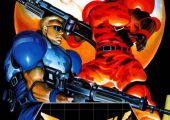
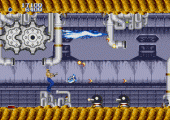
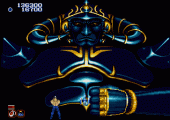
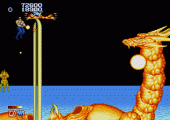
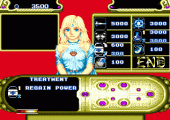
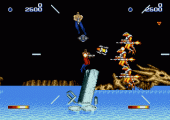
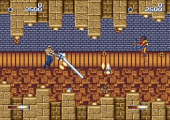
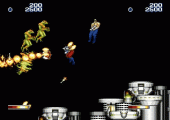
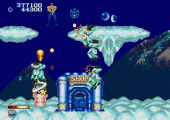
Good game, but the rotation function can be a bit tricky to get used to
This is one of only a few shmups that don’t feature a spaceship as the main protagonist. Add a two-player mode, and even an RPG element in the form of shops that sell weapon upgrades and you got yourself a pretty good game. Keep in mind that this was an early effort. Definitely impressive.
An 8/10 from me.
One of my first Genesis games, and one that still holds up pretty good. One player mode is pretty tough, two player rather easy, though.
Still one of my all time favorites. This game might not have all the bells and whistles (or levels) of the TG-CDROM version, but the two-player mode makes it worthwhile. Great game!